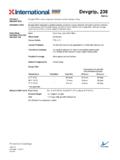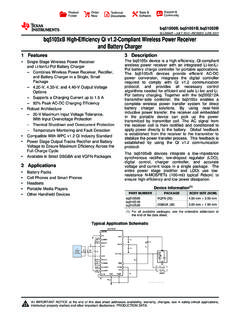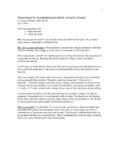Transcription of Perdido - globaldrilling.com
1 Perdido World s deePesT oFFsHore drilling and ProducTion PlaTFormsupplement toCustomCustomPublishingPublishing Shell PerDiDoContentsstrategiC DeveloPment 2subsea sYstem 6the sPar 15the toPsiDes 22 DeveloPing the fielD 28the exPort sYstem 34oPerations 40 ComPanY Profiles 46 Supplement to:VP, PennWell Custom Publishing, Roy Editor and Principal WriterRichard Cunningham Writers,Jerry Jay PhotographersTravis Editor/Designer, Chad Manager, Dorothy Manager, Tommie Petroleum Group1455 West Loop South, Suite 400 Houston, TX 77027 fax: Corporate Headquarters1421 S. Sheridan Rd., Tulsa, OK Lauinger, 1900 1988 Chairman, Frank T.
2 LauingerPresident/CEO, Robert F. BiolchiniSponsored by: 1 We are building on a shell s long history of successful deepwater projects. that combina-tion of experience and ability has allowed us to take this next big step. Joe Leone vice President, Developing assets the second deepest drilling and production plat-form in the world is in 6,300 feet of water. the idea of bringing full functionality to waters nearly 8,000 feet deep and 200 miles from the onshore base is a big step for the industry. Dale SnyderPerdido Project manager Perdido demonstrates shell s ability to com-bine creativity and technology to safely push back deepwater boundaries.
3 This develop-ment paves the way for going beyond water depths of 10,000 feet. Bill TownsleyPerdido venture manager1000 ft2000 ft3000 ft4000 ft5000 ft6000 ft7000 ft8000 ft9000 ft10,000 ft Deepest spar in the world / Deepest drilling and production facility in the world Deepest producing subsea wellshell PerDiDoshell Perdido 3 When shell acquired the ultra-deepwater leases for Perdido in 1996, the technology to develop them didn t exist. there were other notable deepwater developments, of course. each had pushed the boundaries of technology, but in solv-ing Perdido s many technical challenges, shell has opened new frontiers for oil and gas Perdido oil and gas development covers a portion of the geological formation known as the Perdido fold belt.
4 The producing reservoirs lie within the Paleogene or lower tertiary zone, a portion of the gulf of mexico that has not been produced before. the seabed there resembles a small version of the grand Canyon, including cliffs with near verti-cal drops of up to 1,000 hub of the Perdido development is some 200 miles due south of freeport texas. the nearest neighbor is the hoover-Diana platform, about 60 miles to the north. shell began 3D seismic surveys on Perdido in 1998. the discovery well was completed in 2002. Development drill-ing began in 2007 and is scheduled to continue through 2016. there is a lot of courage in this story, says bill townsley, Perdido venture manager.
5 We purchased the Perdido leases in up to 10,000 feet of water at a time when the industry s capability was barely 3,000 feet. one of our satellite well-heads will be installed at 9,627 feet. A workAble plAn i joined the project in January of 2005, says Dale snyder, Perdido project manager. by the end of the year, we d settled on a development concept and begun the front-end engineering and design. safety, cost and functionality were the project team s primary concerns. a large tension-leg platform common on other deepwater developments wouldn t work at Perdido because of the extreme water depths. Whatever floats on the surface has to support the weight of everything below, so in Perdido s case, just the weight of the mooring lines, risers and other equipment hanging from the platform would be overwhelming.
6 Engineers also had to design for the higher crushing pressures of depths greater than 9,000 feet, and other environmental forces such as storm-driven waves, hurricane-force winds and the gulf of mexi-co s strong loop currents. the deeper you go, the bigger these structures strategiC DeveloPment on the outer eDgestrategiC DeveloPment on the outer eDgeDale Snyder, Perdido project manager4shell PerDiDoget unless you break the pattern, snyder says. for Per-dido, we also have reservoirs that are atypical for the gulf of mexico. because of low reservoir pressures and the variety of our target zones, Perdido requires a lot of wells.
7 There are up to 35 wells in the Perdido development plan. twenty-two are directly under the spar. a conventional deepwater production system would require 22 risers with all their associated bulk and weight. economically, we just couldn t make that work, snyder says. it is very expensive to solve the technical problems and operate things at extreme water depths. beyond that, if you build a mammoth structure, the cost of construction becomes prohibitive. for Perdido , we wanted a new kind of deepwater platform, one that was light enough to be eco-nomical, yet big and sturdy enough to contain all the drilling and production equipment we needed to develop the field.
8 The Perdido concept design team wanted a central platform with full drilling and production capability onboard. before Perdido , the world s deepest water depth for such a platform was 6,300 feet, but several emerging technolo-gies, including direct vertical access to the wells (Dva) and a subsea boosting system allowed the engineering and design team to greatly reduce the size of the structure. We needed to be able to pump liquids from the seabed to the surface, snyder explains. in shallower waters, that s not a big issue, but when the water is a mile and a half deep, it takes a lot of pressure to move fluids up to the platform.
9 Most new reservoirs have enough internal pressure to overcome the hydrostatic pressure above them and push fluids up the wellbore to the surface. Perdido s reservoirs are relatively low pressure, so we needed a boosting system. the other significant challenge was the potential of form-ing hydrates an icy mix of water and natural gas that can easily clog flowlines. the solution was to separate gas and liquids on the seabed, then let the subsea boosting system push them to the surface, each through different lines. With that capability, the design team could comingle fluids from all the wells on the seafloor, before pumping it to the surface.
10 It was part of the enabling technology. instead of 22 production risers from 22 wells, they only needed five, and with just five risers, Perdido could be a much smaller platform. Photo provided by noble Corporation 5 TArgeT Zerofrom the beginning, the safety of the workforce was a critical design element for the engineering team. no project manag-ers want to have injuries on the job, but the remoteness of the Perdido development presented some unique challenges. We started off in 2005 with the idea that safety was the most important thing we would do on Perdido , snyder recalls. We would get it right. We would be a world leader in safety, and we put tremendous effort into that.







